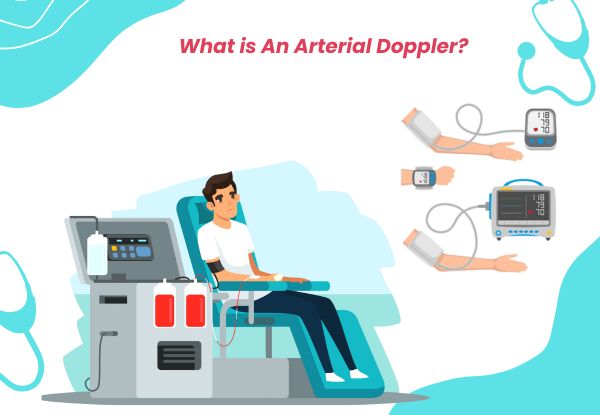
Introduction
Blood circulation is essential for the body to function properly. When arteries develop blockages or narrow over time, it can lead to serious health complications. Arterial Doppler is a non-invasive test that helps evaluate blood flow in the arteries, detecting any abnormalities that may indicate underlying vascular conditions.
Doctors recommend an arterial doppler test to assess conditions such as peripheral artery disease (PAD), blood clots, and other circulation-related disorders. Early detection of vascular issues can prevent serious complications like strokes or chronic leg pain.
A vascular doppler test is crucial for individuals experiencing symptoms like leg pain while walking, cold feet, or numbness. It helps doctors determine if the arteries are supplying enough oxygenated blood to different parts of the body.
By identifying circulation issues early, medical professionals can recommend lifestyle changes, medications, or further medical interventions to prevent worsening conditions.
Understanding Arterial Doppler
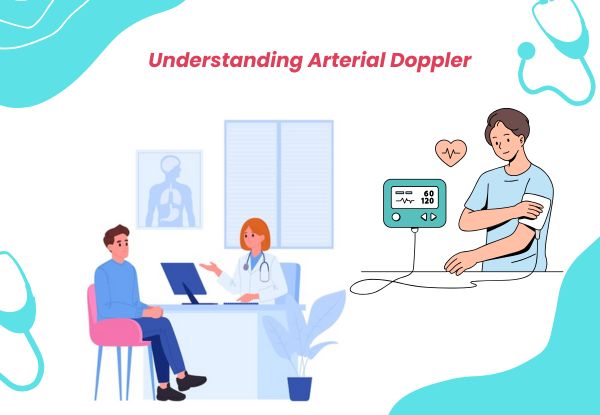
An arterial doppler is a specialized ultrasound test used to evaluate blood flow through the arteries. It helps detect blockages, narrowing, or any irregularities that could impact circulation. By using sound waves, this non-invasive test creates images showing how blood moves through the vessels, helping doctors assess the overall health of the arteries.
How It Works: Sound Waves and Blood Flow
The arterial doppler scan relies on high-frequency sound waves that bounce off moving blood cells. These sound waves produce images and audio signals, allowing healthcare professionals to observe the speed and direction of blood flow.
When blood moves smoothly through the arteries, the sound remains steady. However, blockages or narrowing can alter the flow, producing irregular sounds and indicating potential issues.
The Difference Between Arterial and Venous Doppler
While both tests use similar technology, the focus differs. An arterial doppler assesses blood flow in the arteries, which carry oxygen-rich blood from the heart to the body. On the other hand, a venous doppler evaluates veins, which return deoxygenated blood back to the heart.
An arterial and venous doppler may be recommended when a comprehensive view of both systems is needed, especially in cases involving circulation issues or blood clots.
Why is an Arterial Doppler Done?
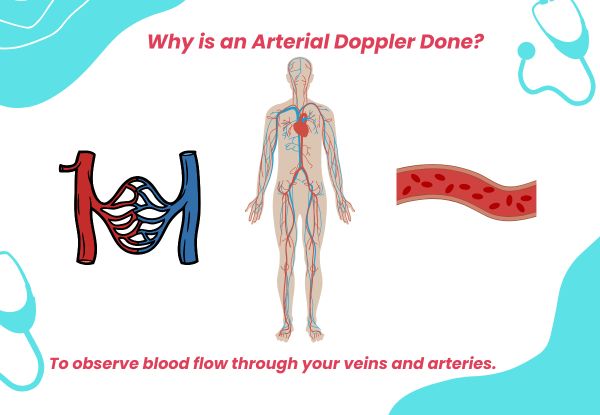
An arterial colour doppler is often recommended to assess the health of your arteries and detect conditions that could affect blood circulation. It plays a crucial role in identifying blockages or abnormalities that may lead to more severe health problems if left untreated.
Common Conditions It Helps Diagnose
One of the most common uses of an arterial doppler is to diagnose peripheral artery disease (PAD). This condition occurs when arteries in the legs narrow due to plaque buildup, reducing blood flow. A doppler test for legs can help detect PAD early, preventing complications like ulcers or even limb loss.
In addition to PAD, the test can identify other vascular issues such as:
- Blood clots that may obstruct blood flow.
- Aneurysms, which are bulges in artery walls that can rupture if left unchecked.
- Arterial insufficiency, where the arteries fail to supply enough oxygenated blood to specific body parts.
An arterial venous doppler may also be used to evaluate both arteries and veins, providing a complete picture of circulation and helping diagnose conditions like deep vein thrombosis (DVT) alongside arterial blockages.
Signs That Suggest You Might Need the Test
Your doctor may recommend an arterial doppler if you experience symptoms such as:
- Leg pain or cramping during walking, which improves with rest (a classic sign of PAD).
- Numbness, tingling, or weakness in the legs.
- Coldness in the lower legs or feet compared to other areas.
- Sores on your feet or legs that heal slowly.
- A weak or absent pulse in the legs.
These symptoms often signal restricted blood flow and should not be ignored.
Benefits of Early Detection
The primary advantage of an arterial colour doppler is its ability to detect vascular issues early. When caught in the initial stages, conditions like PAD can be managed effectively with lifestyle changes, medications, or minimally invasive procedures. Early diagnosis helps reduce the risk of severe complications, such as stroke, heart attack, or amputation.
This non-invasive test provides valuable insights, allowing for timely treatment and improving long-term health outcomes.
Arterial Doppler Procedure
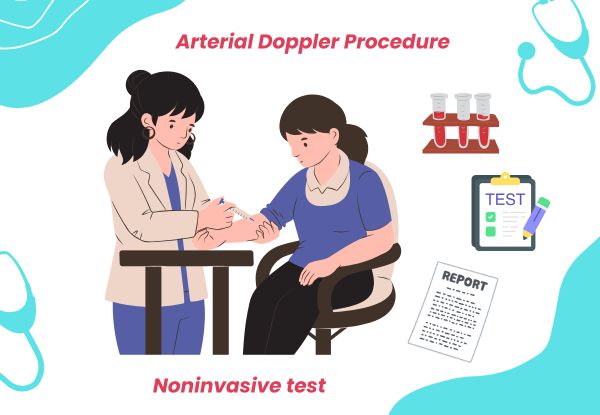
Understanding what to expect during an arterial doppler test can help ease any concerns. This non-invasive procedure is straightforward, painless, and offers valuable insights into your vascular health.
What to Expect Before, During, and After the Test
Before the Test:
In most cases, no special preparation is needed. However, if you’re undergoing an arterial doppler lower limb scan, your doctor might advise you to avoid smoking or consuming caffeine for a few hours beforehand, as these can affect blood flow and lead to less accurate results.
It’s also a good idea to wear loose, comfortable clothing to allow easy access to the area being examined.
During the Test:
The procedure is conducted by a trained technician or vascular specialist. You’ll be asked to lie down on an examination table. For an arterial doppler lower limb test or a colour doppler test for legs, the technician will apply a special gel to your skin. This gel helps transmit sound waves and ensures clear imaging.
A handheld device called a transducer is then moved over the area being examined. The transducer emits sound waves that bounce off the blood cells moving through your arteries. These waves are converted into images and sounds that the technician monitors in real-time.
You might hear swishing or whooshing noises during the test, which represent your blood flow. In some cases, you may be asked to perform simple movements, like flexing your foot or holding your breath, to assess how blood flow changes under different conditions.
After the Test:
Once the arterial doppler test is complete, the gel is wiped off, and you can resume your normal activities immediately. There are no side effects or recovery time needed. Your doctor will review the images and sounds to identify any abnormalities in blood flow and discuss the results with you.
Is It Painful?
One of the main benefits of the arterial doppler test is that it is completely painless. The transducer may apply slight pressure, especially if the technician needs a clearer image of deeper arteries, but it shouldn’t cause any discomfort. The procedure is non-invasive, meaning there are no needles, incisions, or exposure to radiation.
How Long Does It Take?
The duration of the test depends on the area being examined and the complexity of the case. A standard colour doppler test for legs typically takes about 30 to 45 minutes. If a more comprehensive scan is needed, such as evaluating both the arterial doppler lower limb and upper body, it may take up to an hour.
Despite the time, the procedure is straightforward and allows you to return to your routine immediately afterward.
Preparation and Aftercare

Being well-prepared for your vascular doppler test can help ensure accurate results, and knowing what to expect afterward makes the process smoother. Here’s how to get ready for an arterial doppler scan and what to do once the procedure is complete.
How to Prepare for the Test
Preparing for an arterial doppler scan is usually simple. Since the procedure is non-invasive, extensive preparation isn’t necessary. However, following these basic steps can help the process go smoothly:
- Clothing: Wear loose, comfortable clothes that allow easy access to the area being examined. For a doppler test for legs, shorts or loose-fitting pants are ideal.
- Avoid Smoking and Caffeine: If your doctor advises, avoid smoking or consuming caffeine for several hours before the test. Both can constrict blood vessels, potentially affecting blood flow and leading to inaccurate results.
- Medication: In most cases, you can continue taking your regular medications unless instructed otherwise. Always inform your doctor about any prescriptions or over-the-counter drugs you are using.
- Hydration and Fasting: For most vascular doppler tests, there’s no need to fast. However, if the scan focuses on abdominal arteries, your doctor might recommend fasting for a few hours beforehand to reduce gas that could interfere with the imaging.
Post-Procedure Tips and Follow-Up Care
After the arterial doppler scan, you can resume your usual activities right away. There’s no recovery time or special care required, but here are a few helpful tips:
- Wipe Off the Gel: The technician will clean off the ultrasound gel used during the test, but you may want to double-check before leaving the clinic.
- Stay Active: Unless your doctor advises otherwise, it’s safe to return to your normal routine, including walking or exercising.
- Monitor Symptoms: Pay attention to any ongoing symptoms like leg pain or numbness, especially if they were the reason for your doppler test for legs. If symptoms worsen or new ones appear, notify your doctor.
Safety and Risks
One of the reasons doctors frequently recommend the vascular doppler is its excellent safety profile. The test is non-invasive and uses sound waves instead of radiation, making it safe for most people, including pregnant women.
Potential risks are minimal, but here’s what to consider:
- Mild Discomfort: You may feel slight pressure from the transducer during the arterial doppler scan, especially over sensitive areas or if the technician needs to press to get a clearer image. This discomfort is temporary and usually minor.
- No Side Effects: There are no side effects or complications directly associated with the test. Since no needles or contrast dyes are used, there’s no risk of allergic reactions or infections.
Your doctor will review the results and recommend the next steps based on the findings. If any issues are detected, they might suggest lifestyle changes, medication, or further testing.
Understanding Your Arterial Doppler Results
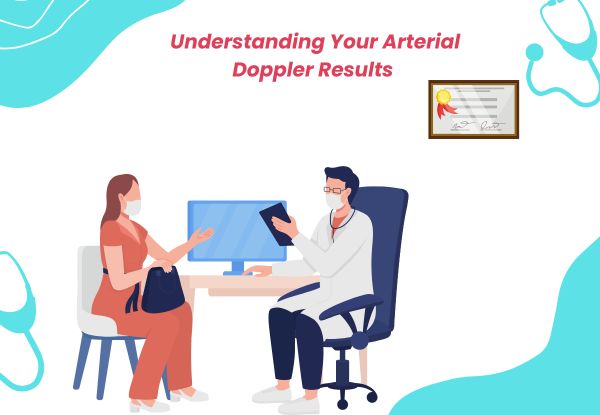
After completing an arterial colour doppler, your doctor will review the images and sounds collected during the test to assess blood flow and detect any abnormalities. Understanding what these results mean is essential to determine the next steps for your health.
What the Results Might Show
A vascular doppler evaluates how well blood flows through your arteries and highlights any irregularities. The results typically fall into one of these categories:
- Normal Blood Flow: If the arteries are clear and blood flows smoothly, the results will be considered normal. This indicates no blockages or narrowing.
- Reduced Blood Flow: A common finding in patients with peripheral artery disease (PAD), reduced flow suggests narrowing or blockages due to plaque buildup.
- Abnormal Flow Patterns: Turbulent or irregular blood flow can signal areas where arteries have become narrow or damaged. This is often seen in arterial doppler lower limb tests when blockages limit blood supply to the legs.
- Complete Blockages: In some cases, the arterial colour doppler may reveal total obstructions, preventing blood from flowing through certain arteries.
The arterial doppler lower limb test often highlights issues in the legs, where symptoms like pain or numbness are common indicators of restricted circulation.
What to Do if Abnormalities Are Found
If your vascular doppler reveals abnormalities, your doctor will guide you through the next steps. Common approaches include:
- Lifestyle Changes: Managing conditions like PAD often starts with lifestyle adjustments. This can include quitting smoking, eating a balanced diet, and exercising to improve circulation.
- Medications: Your doctor may prescribe medications to help manage cholesterol, blood pressure, or clotting, reducing the risk of further arterial damage.
- Further Testing: In some cases, additional imaging tests like an angiogram may be recommended to get a more detailed view of the arteries.
- Surgical Options: If blockages are severe, procedures such as angioplasty or bypass surgery may be considered to restore blood flow.
Next Steps and Treatment Options
After discussing your arterial colour doppler results, your doctor will create a treatment plan tailored to your specific condition. Treatment often focuses on improving blood flow, managing symptoms, and preventing future complications.
For patients with arterial doppler lower limb abnormalities, simple changes like regular walking exercises can significantly improve blood flow and reduce discomfort. In more serious cases, medical interventions can help restore proper circulation and reduce the risk of severe complications like ulcers or limb loss.
Choosing the Right Diagnostic Center

Selecting the right facility for an arterial doppler in Mumbai is essential for accurate diagnosis and effective treatment planning. The quality of equipment, expertise of the medical team, and overall patient care can significantly impact the experience and reliability of the results.
What to Look for in a Diagnostic Center
When choosing a center for an arterial doppler in Mumbai, consider the following factors:
- Qualified Specialists: Ensure the center has experienced radiologists or vascular specialists who can accurately interpret the results.
- Advanced Imaging Equipment: Modern ultrasound machines provide clearer images, leading to precise diagnosis and better treatment decisions.
- Comprehensive Services: A center that offers a wide range of vascular imaging tests, including arterial and venous doppler, can provide a more detailed assessment of your condition.
- Patient-Centric Approach: A diagnostic center should prioritize patient comfort, clear communication, and timely results.
Why Experience and Equipment Matter
A well-equipped diagnostic center with trained professionals ensures that the test is conducted properly and results are interpreted accurately. Advanced doppler ultrasound technology improves the detection of blockages, narrowing, or abnormal blood flow patterns, allowing for early intervention when needed.
At an experienced facility, technicians understand how to adjust the test based on individual needs, ensuring accurate readings and minimizing any discomfort during the procedure.
Top-Notch Care At Midas Care Clinic
For individuals looking for the best diagnostic center in Mumbai for vascular imaging, Midas Care Clinic is a trusted choice. The clinic is known for its state-of-the-art equipment and highly trained professionals, ensuring accurate and reliable arterial doppler assessments.
Patients at Midas Care Clinic receive expert care, clear explanations of their results, and guidance on the next steps for maintaining vascular health. Whether it’s a routine check-up or an evaluation for existing symptoms, the clinic provides comprehensive diagnostic support tailored to individual health needs.
Expert Opinion: Insights from Specialist

Seeking advice from an experienced specialist is essential when evaluating vascular health. Dr Chandrakant, a trusted expert in vascular care, emphasizes the importance of early detection and proper management of circulation issues.
Quotes and Tips from Experienced Doctor
According to Dr Chandrakant, an arterial doppler near me is one of the most effective tools in diagnosing vascular conditions before they progress into more severe complications. He explains,
“Many patients ignore symptoms like leg pain or numbness, assuming they are minor issues. However, these could be early signs of restricted blood flow. An arterial doppler is a simple, non-invasive way to detect and manage these conditions before they lead to serious health risks.”
Doctors specializing in vascular health recommend this test for individuals experiencing:
- Leg pain while walking (a symptom of peripheral artery disease).
- Numbness or coldness in the legs or feet.
- Non-healing wounds or ulcers on the lower limbs.
These symptoms often indicate blockages in the arteries, which can be managed effectively with early intervention.
FAQs
Q1. What is an arterial Doppler and why is it done?
Ans: An arterial doppler test is a non-invasive ultrasound that evaluates blood flow through your arteries. It’s commonly used to detect blockages, narrowing, or other issues that may affect circulation. The test is often done to diagnose conditions like peripheral artery disease (PAD) and monitor blood flow in patients with known vascular issues.
Q2. Is an arterial Doppler test painful?
Ans: No, the arterial doppler test is completely painless. A technician uses a handheld device called a transducer, which glides over your skin with a special gel to capture images of your arteries. You might feel slight pressure during the test, but it shouldn’t cause any discomfort.
Q3. How do I prepare for an arterial Doppler?
Ans: Most arterial doppler tests don’t require special preparation. Wear loose clothing that allows easy access to the area being examined. If the test focuses on abdominal arteries, your doctor might advise fasting for a few hours before the procedure. For a doppler test for legs, no fasting is necessary, but avoiding caffeine and smoking beforehand can help ensure accurate results.
Q4. How long does the procedure take?
Ans: The duration depends on the area being examined. A standard doppler test for legs usually takes about 30 to 45 minutes, while more detailed tests may last up to an hour. Despite the time, the procedure is non-invasive, and you can return to your daily activities immediately afterward.
Q5. What conditions can an arterial Doppler detect?
Ans: An arterial doppler test helps detect a variety of vascular conditions, including:
- Peripheral artery disease (PAD)
- Blood clots
- Aneurysms
- Arterial blockages or narrowing
- Reduced blood flow in the legs or other extremities
A comprehensive arterial venous doppler can also assess the veins, helping detect conditions like deep vein thrombosis (DVT).
Q6. Can I eat before the test?
Ans: For most arterial doppler tests, you can eat and drink normally before the procedure. However, if the test focuses on abdominal arteries, your doctor might recommend fasting for a few hours to reduce gas in the intestines, which can interfere with the imaging.
7. Is an arterial Doppler safe?
Yes, the arterial doppler test is entirely safe. It uses sound waves to create images and does not involve radiation, making it safe for all patients, including pregnant women. Since it’s non-invasive, there are no risks of infection or allergic reactions.
Q8. What’s the difference between arterial and venous Doppler?
Ans: An arterial doppler focuses on arteries that carry oxygen-rich blood from the heart to the body. A venous doppler, on the other hand, examines veins that return deoxygenated blood to the heart. A combined arterial venous doppler may be recommended to assess both systems, especially when investigating circulation issues.
Q9. How accurate is the test?
Ans: When performed by experienced technicians using advanced equipment, an arterial doppler test is highly accurate in detecting blockages, narrowing, and other vascular issues. It’s a reliable tool for early diagnosis and monitoring of vascular health.
Q10. Where can I get an arterial Doppler in Mumbai?
Ans: If you’re looking for an arterial doppler in Mumbai, Midas Care Clinic offers expert vascular imaging services. With state-of-the-art equipment and skilled specialists, the clinic provides accurate assessments and personalized care for all your vascular health needs.
Conclusion
Understanding what is an arterial doppler and its role in assessing blood flow is crucial for maintaining good vascular health. This non-invasive test provides valuable insights into how well your arteries are functioning, helping to detect conditions like peripheral artery disease (PAD), blood clots, and other circulation issues before they become serious health concerns.
If you experience symptoms such as leg pain, numbness, or persistent coldness in your limbs, it may be a sign of restricted blood flow. Consulting a healthcare professional for an arterial doppler near me can help identify potential issues early, allowing for timely treatment and better health outcomes.
For those seeking expert care and precise diagnostic services, Midas Care Clinic offers advanced vascular imaging, including arterial doppler tests conducted by experienced specialists. The clinic is dedicated to providing accurate assessments and personalized care, ensuring you receive the attention and treatment you need.
Don’t wait until symptoms worsen. If you suspect any circulation issues, schedule your appointment at Midas Care Clinic today and take a proactive step toward protecting your vascular health.

